Last updated: March 19, 2025
Article
Climate and Water Monitoring at Organ Pipe Cactus National Monument: Water Year 2022

NPS
Overview
Together, climate and hydrology shape ecosystems and the services they provide, particularly in arid and semi-arid ecosystems. Understanding changes in climate, groundwater, and surface water is key to assessing the condition of park natural resources—and often, cultural resources.
At Organ Pipe Cactus National Monument (Figure 1), Sonoran Desert Network scientists study how ecosystems may be changing by taking measurements of key resources, or “vital signs,” year after year—much as a doctor keeps track of a patient’s vital signs. This long-term ecological monitoring provides early warning of potential problems, allowing managers to mitigate them before they become worse. At Organ Pipe Cactus National Monument, we monitor climate, groundwater, and springs, among other vital signs.
Surface-water and groundwater conditions are closely related to climate conditions. Because they are better understood together, we report on climate in conjunction with water resources. Reporting is by water year (WY), which begins in October of the previous calendar year and goes through September of the water year (e.g., WY2022 runs from October 2021 through September 2022).
This article reports the results of climate and water monitoring at Organ Pipe Cactus National Monument (Figure 1) in WY2022.
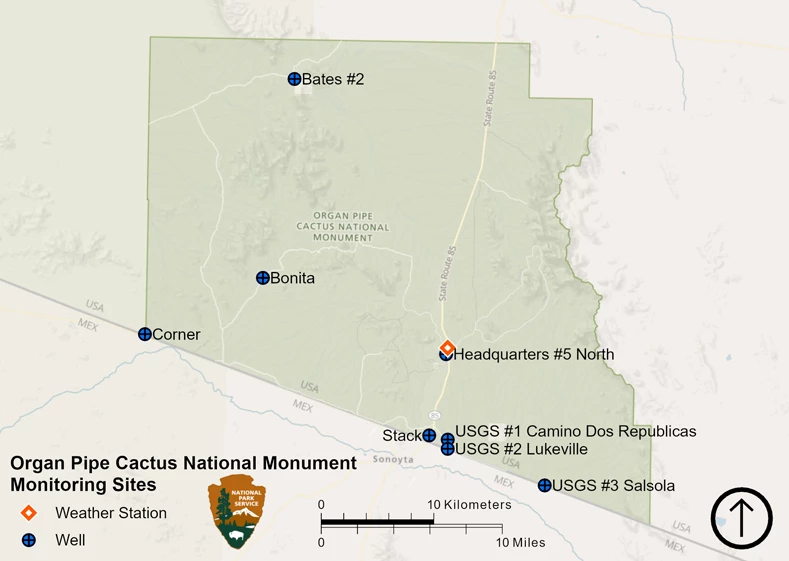
NPS
Climate and Weather
There is often confusion over the terms “weather” and “climate.” In short, weather describes instantaneous meteorological conditions (e.g., it’s currently raining or snowing, it’s a hot or frigid day). Climate reflects patterns of weather at a given place over longer periods of time (seasons to years). Climate is the primary driver of ecological processes on earth. Climate and weather information provide context for understanding the status or condition of other park resources.
Methods
A National Oceanic and Atmospheric Administration (NOAA) Cooperative Observer Program (COOP) weather station, “Organ Pipe Cactus Natl Mon AZ” (ID# 026132), has been operational at Organ Pipe Cactus National Monument since 1944 (Figure 1). This station provides a reliable, long-term climate dataset used for analyses in this report. Data from this station are accessible through Climate Analyzer.
Results for Water Year 2022
Precipitation
Annual precipitation at Organ Pipe Cactus National Monument in WY2022 was 8.04″ (20.4 cm; Figure 2), which was 1.24″ (3.1 cm) less than the 1991–2020 annual average. This deficit primarily occurred October through May when monthly precipitation totals were ≤ 35% of the 1991–2020 monthly averages, except in December. Monsoon rains (June–September) were 21–73% above average, but these surpluses did not completely make up for the drier fall, winter, and spring. Extreme daily rainfall events (≥ 1″; 2.54 cm) occurred on 2 days, which is the same as the average annual frequency of 2.1 days. Extreme rainfall events occurred on 31 December 2021 (1.21″; 3.1 cm) and 24 July 2022 (1.30″; 3.3 cm).
Air Temperature
The mean annual maximum air temperature at Organ Pipe Cactus National Monument in WY2022 was 88.8°F (31.5°C), 1.4°F (0.8°C) above the 1991–2020 average. The mean annual minimum temperature in WY2022 was 58.5°F (14.7°C), 1.9°F (1.1°C) above the 1991–2020 average. Mean monthly maximum and minimum temperatures in WY2022 were warmer than the 1991–2020 monthly averages for most of the year, differing by as much as 6.7°F (3.7°C, see December; Figure 2). October was the only month that both mean maximum and minimum temperatures were cooler than average. Extremely hot temperatures (≥ 107°F; 41.7°C) occurred on 23 days on in WY2022, similar to the average frequency of 21.8 days. Extremely cold temperatures (≤ 35°F; 1.7°C) occurred on 7 days, substantially less than the average frequency of 20.1 days.
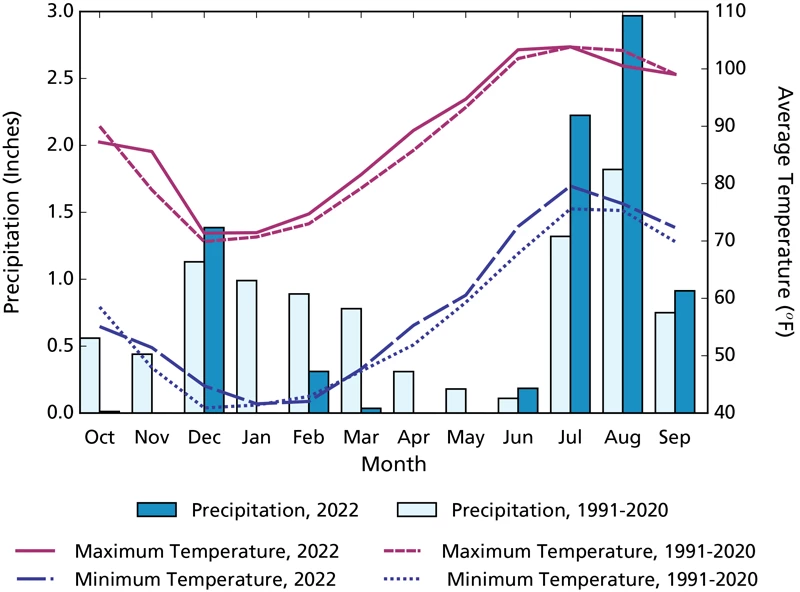
NPS
Drought
Reconnaissance drought index (Tsakiris and Vangelis 2005) provides a measure of drought severity and extent relative to the long-term climate. It is based on the ratio of average precipitation to average potential evapotranspiration (the amount of water loss that would occur from evaporation and plant transpiration if the water supply was unlimited) over short periods of time (seasons to years). The reconnaissance drought index for Organ Pipe Cactus National Monument indicates that WY2022 was drier than the 1991–2022 average, from the perspective of both precipitation and potential evapotranspiration (Figure 3).
Reference: Tsakiris G., and H. Vangelis. 2005. Establishing a drought index incorporating evapotranspiration. European Water 9: 3–11.
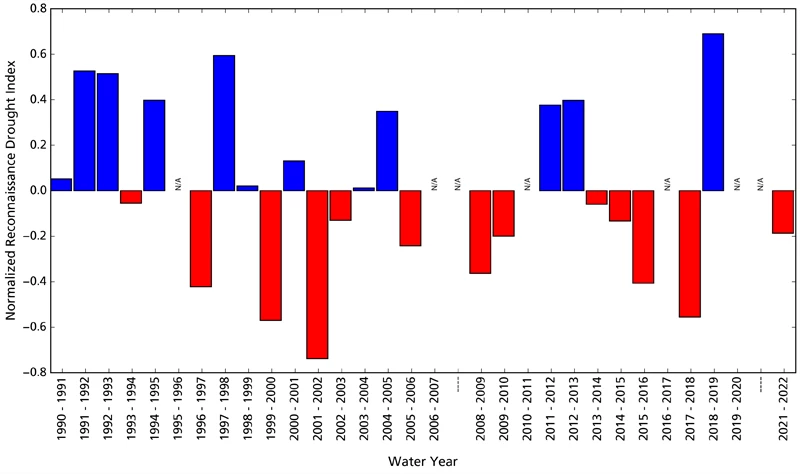
NPS
Groundwater
Groundwater is one of the most critical natural resources of the American Southwest. It provides water for drinking, irrigating crops, and sustaining rivers, streams, and springs throughout the region.
Methods
At Organ Pipe Cactus National Monument, groundwater is monitored using eight wells: Bates, Bonita, Corner, Headquarters #5, Stack, USGS #1, USGS #2, and USGS #3 (Figure 1). In WY2020, continuous monitoring began at four wells: Bates, Headquarters #5, USGS #2, and USGS #3. Prior to WY2020, Headquarters #5 was monitored annually by the Arizona Department of Water Resources (ADWR). ADWR data are available from the ADWR Well Registry Search.
Results for Water Year 2022
Average groundwater levels in six wells decreased between WY2021 and WY2022: Bates #2, Headquarters #5, Stake, USGS #1, USGS #2, and USGS #3 (Figure 4; Table 1). Each of these six wells recorded their lowest water level of monitoring record in WY2022. Bonita is the only well where water level increased since the previous year. Comparisons to the previous water year could not be made in Corner well because no groundwater measurements were made in WY2021. Stack, USGS #1, and USGS #2 have shown similar rates of decline over the monitoring record with seasonal fluctuations, likely due to groundwater pumping south of the US–Mexico border. Headquarters #5 has also shown similar rates of decline to Stack, USGS #1, and USGS #2 but there is no evident seasonal fluctuation. While the depth-to-water at Headquarters #5 is much deeper than the other wells, its water-level elevation is slightly higher, indicating that it is upgradient and within the same aquifer as the other wells. Groundwater levels in Corner well have also been declining, but much more gradually. Groundwater levels in Bates #2 and Bonita, which are both shallow wells, have been more variable over the monitoring record, indicating that these wells are more impacted by precipitation and local recharge and less impacted by groundwater withdrawals. Groundwater levels in USGS #3 have only varied 10 feet over the monitoring period; however, a decline starting in WY2020 has been more rapid than in earlier periods. Geologic activity and groundwater withdrawals in the area may be the cause of this recent decline in USGS #3.
| Name | State Well Number | Wellhead Elevation (est. ft amsl) |
Average Depth to Water (ft bgs) |
Average Water Level Elevation (ft amsl) |
Change in Elevation from WY2021 (± ft) |
Change from Earliest Recorded Water Level (± ft) (year of earliest record) |
|---|---|---|---|---|---|---|
| Bates #2 (Bates East) | 632186 | 1,350.00 | 40.54 | 1309.46 | −1.58 | 0.32 (2010) |
| Bonita | 620153 | 1,355.00 | 28.02 | 1326.98 | 2.96 | −6.32 (1984) |
| Corner | n/a | 1,000.00 | 62.68 | 937.32 | n/a | −4.23 (1984) |
| Headquarters #5 (North) | 629090 | 1,660.00 | 353.57 | 1306.43 | −0.76 | −42.44 (1976) |
| Stack | n/a | 1,405.00 | 131.23 | 1273.77 | −1.22 | −36.31 (1985) |
| USGS #1 (Camino Dos Republicas) | 522034 | 1,400.00 | 118.22 | 1281.78 | −1.08 | −32.02 (1988) |
| USGS #2 (Lukeville) | 522035 | 1,390.00 | 105.61 | 1284.39 | −0.09 | −33.91 (1988) |
| USGS #3 (Salsola) | 522033 | 1,466.50 | 103.74 | 1362.76 | −0.89 | −1.64 (1988) |
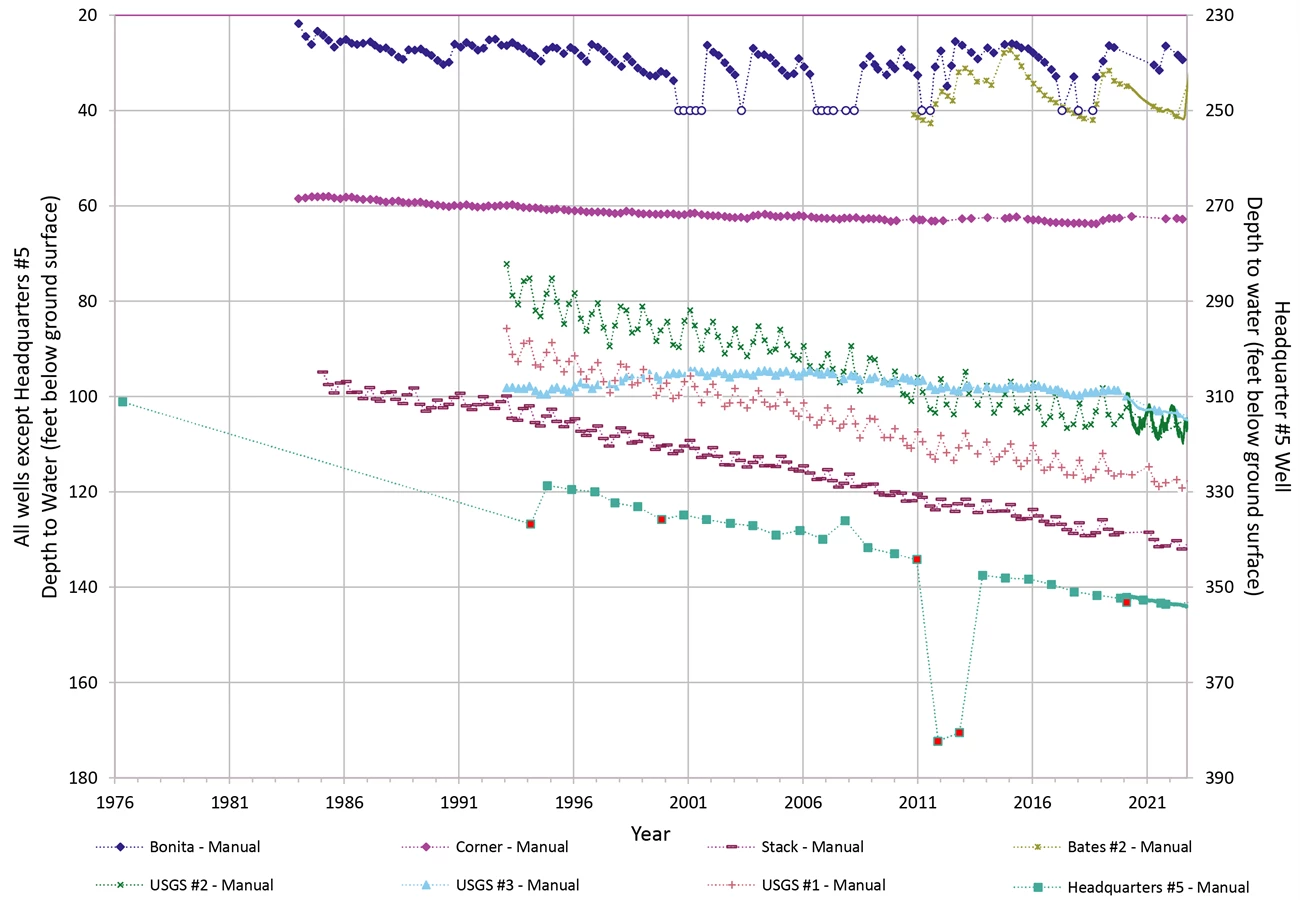
NPS
Springs
Background
Springs, seeps, and tinajas (small pools in a rock basin or impoundments in bedrock) are small, relatively rare biodiversity hotspots in arid lands. They are the primary connection between groundwater and surface water and are important water sources for plants and animals. For springs, the most important questions we ask are about persistence (How long was there water in the spring?) and water quantity (How much water was in the spring?).
Methods
Sonoran Desert Network springs monitoring is organized into four modules described below.
Site Characterization
This module, which includes recording GPS locations and drawing a site diagram, provides context for interpreting change in the other modules. We also describe the spring type (e.g., helocrene, limnocrene, rheocrene, or tinaja) and its associated vegetation. Helocrene springs emerge as low-gradient wetlands, limnocrene springs emerge as pools, and rheocrene springs emerge as flowing streams. This module is completed once every five years or after significant events.
Site Condition
We estimate natural and anthropogenic disturbances and the level of stress on vegetation and soils on a scale of 1–4, where 1 = undisturbed, 2 = slightly disturbed, 3 = moderately disturbed, and 4 = highly disturbed. Types of natural disturbances can include flooding, drying, fire, wildlife impacts, windthrow of trees and shrubs, beaver activity, and insect infestations. Anthropogenic disturbances can include roads, off-highway vehicle trails, hiking trails, livestock and feral-animal impacts, removal of invasive non-native plants, flow modification, and evidence of human use of the spring. We take repeat photographs showing the spring and its landscape context. We note the presence of certain obligate wetland plants (plants that almost always occur only in wetlands), facultative wetland plants (plants that usually occur in wetlands, but also occur in other habitats), and non-native bullfrogs and crayfish, and we record the density of invasive, non-native plants.
Water Quantity
We measure the persistence of surface water, amount of spring discharge, and wetted extent (area that contained water). To estimate persistence, we analyze the variance of temperature measurements taken by logging thermometers placed at or near the orifice (spring opening). Because water mediates variation in diurnal temperatures, data from a submerged sensor will show less daily variation than data from an exposed open-air sensor; this tells us when the spring was wet or dry. Surface discharge is measured with a timed sample of water volume. Wetted extent is a systematic measurement of the physical length (up to 100 m), width, and depth of surface water. It is assessed using a technique for either standing water (e.g., limnocrene and helocrene springs) or flowing water (e.g., rheocrene springs).
Water Quality
We measure core water quality parameters and water chemistry. Core parameters include water temperature, pH, specific conductivity (a measure of dissolved compounds and contaminants), dissolved oxygen (how much oxygen is present in the water), and total dissolved solids (an indicator of potentially undesirable compounds). Discrete samples of these parameters are collected with a multiparameter meter. If the meter fails calibration check(s), we indicate that condition when presenting data. Water chemistry is assessed by collecting surface water sample(s) and estimating the concentration of major ions with a photometer in the field. These parameters are collected at one or more sampling locations within a spring. Data are presented only for the primary sampling location. Each perennial spring is somewhat unique, and there are not water quality standards specific to most perennial springs in Arizona. Where conditions exceed water quality standards for other surface waters (rivers, streams, lakes, and reservoirs) we note it, but the reader is advised that these standards were not developed for perennial springs. Our ongoing data collection at each spring will improve our understanding of the natural range in water quality and water chemistry parameters for a given site.
Inventory of Rare and Invasive Species and Pathogens
An inventory of rare and invasive species and pathogens in perennial springs was implemented in WY2022 using environmental DNA (eDNA) techniques. Four to 16 water samples were collected and filtered (0.45 µm mesh) from each spring. Samples were preserved in ethanol prior to DNA extraction and analysis by the Goldberg Lab at Washington State University .
Target Organisms for eDNA Project:
-
The non-native invasive American bullfrog (Rana catesbeiana) was previously documented at Organ Pipe Cactus National Monument (Schmidt et al. 2007).
-
The pathogen chytrid fungus (Batrachochytrium dendrobatidis), a major threat to amphibians globally that is currently expanding in the American Southwest, but that has not been previously detected at Organ Pipe Cactus National Monument.
-
Ranaviruses that can infect amphibians and produce 90-100% mortality in tadpoles and adults and can persist in affected wetlands. Ranaviruses have not been previously detected at the park.
-
The native amphibian Chiricahua leopard frog (Rana chiricahuensis), a federally designated threatened species that has not been previously documented within the park (Schmidt et al. 2007). Designated critical habitat is well to the east at Buenos Aries National Wildlife Refuge.
-
The native amphibian lowland leopard frog (Rana yavapaiensis), a species of conservation concern that occurs in the region but that has not been observed within the park (Schmidt et al. 2007).
-
The native aquatic snake northern Mexican garter snake (Thamnophis eques megalops), a federally designated threatened species that has not been previously observed within the park (Schmidt et al. 2007). Designated critical habitat is well to the east at Buenos Aries National Wildlife Refuge.
-
The native mammal jaguar (Panthera onca), a federally designated endangered species that was historically found within Organ Pipe Cactus National Monument. The park lies west of the designated critical habitat for jaguar recovery.
Reference: Schmidt CA and Others. 2007. Vascular Plant and Vertebrate Inventory of Organ Pipe Cactus National Monument. U.S. Geological Survey (USGS) Open-File Report. 2006-1076. USGS Southwest Biological Science Center, Sonoran Desert Research Station, University of Arizona. Tucson, Arizona
List of Springs
Scroll down or click on a spring below to view monitoring results.
Dripping Springs | East Arroyo Spring | Quitobaquito Spring | Snake Pit Tinaja
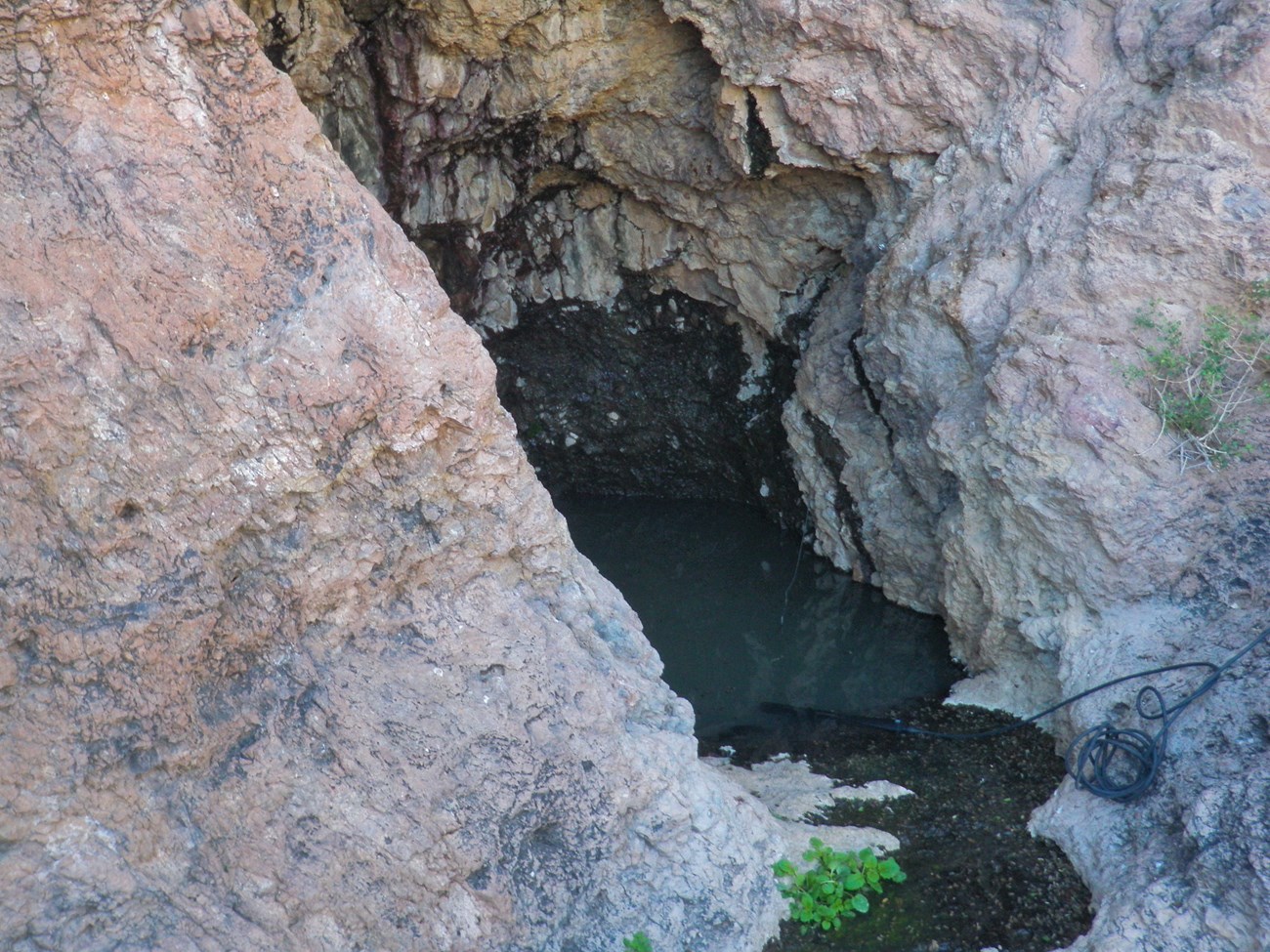
NPS
Recent Findings at Dripping Springs
Dripping Springs is a cave spring (emerges entirely within a cave and not directly connected to surface flow) located in a small (2 x 3 m) cave along a cliff face in the Puerto Blanco Mountains. Numerous groundwater seeps along the bedrock walls of the cave feed a roughly 2 m deep milky blue pool that completely fills the bottom of the small cave. When characterized on 12 March 2022, flow seeped over the cave lip and formed a shallow, sandy outflow channel. As in past years, another orifice in the bedrock wall near the cave supported an active seep. Descriptions and other characteristics of springs are updated every five years. The WY2022 visit occurred on 12 March 2022, and the spring contained water.
Site Condition
We rated Dripping Springs as “moderately disturbed” from insect infestation due to the presence of thousands of European honeybee (Apis mellifera) carcasses that covered the surfaces of both orifices, the cave pool, and the channel in WY2022. We also rated the spring as “slightly disturbed” by invasive wildlife due to the continued extensive European honeybee activity in and around the springbrook and orifices. Although European honeybees have been frequently observed around Dripping Springs, this is the first instance of an infestation. As in the past, the spring was rated “slightly disturbed” from the presence of the Dripping Springs Trail, which brings visitors directly to the site. We observed no other natural or human-caused disturbances at Dripping Springs in WY2022.
Consistent with past site visits, we did not observe crayfish or bullfrogs (non-native invasive aquatic animals) or native obligate/facultative wetland plants in WY2022. Unlike previous years, no non-native plants were detected in or around Dripping Springs in WY2022.
Rare and Invasive Species and Pathogens Inventory
Four water samples were collected and filtered (0.45 µm mesh) from the pool within the cave at Dripping Spring on 12 March 2022. None of our target species were detected.
Water Quantity
Temperature sensors indicated that Dripping Springs was ‘wetted’ (contained water) for all 163 days (100% of days) measured up to the WY2022 visit (Figure 6). In prior water years, the spring was wetted 100% of the days measured.
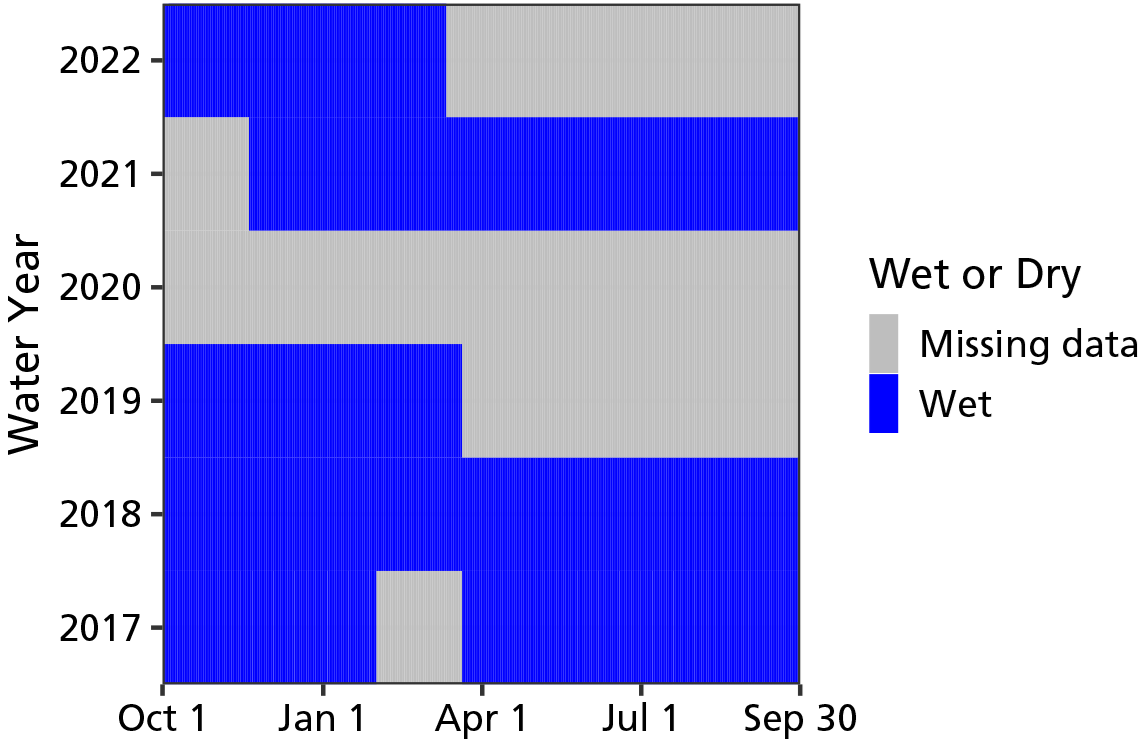
NPS
As in past years, there was no measurable discharge.
Wetted extent for Dripping Springs was evaluated using a method for flowing water in WY2022. The total brook length was 6 m (20 ft), and width and depth averaged 31.8 cm (12.5 in), and 0.2 cm (0.1 in), respectively—within the range of wetted extent measurements observed in previous years.
Water Quality
Core water quality and water chemistry data at Dripping Springs were collected at the primary sampling location. Magnesium was higher and water temperature about 2°C cooler than previously measured at Dripping Springs (Table 3–4). Water chemistry may have been influenced by the presence of thousands of European honeybee carcasses, as has often been encountered at Dripping Springs.
Dripping Springs Data Tables
| Measurement | WY2022 Value (range of prior values) |
Prior Years Measured (# of measurements) |
|---|---|---|
| Width (cm) | 31.8 ± 22.0 (43.0–56.8) | 2018–2021 (3) |
| Depth (cm) | 0.2 ± 0.1 (0.1–0.4) | 2018–2021 (3) |
| Length (m) | 6.0 (2.8–8.3) | 2018–2021 (3) |
| Sampling Location | Measurement Location (width, depth) |
Parameter | WY2022 Value (range of prior values) |
Prior Years Measured (# of measurements) |
|---|---|---|---|---|
| 001 | Center | Dissolved oxygen (mg/L) | 0.09 (0.83–1.68) |
2017–2021 (4) |
| 001 | Center | pH | 7.21 (7.00–7.49) |
2017–2021 (4) |
| 001 | Center | Specific conductivity (µS/cm) | 396.5 (306.5–407.8) |
2017–2021 (4) |
| 001 | Center | Temperature (°C) | 10.3 (12.7–16.1) |
2017–2021 (5) |
| 001 | Center | Total dissolved solids (mg/L) | 258.0 (198.9–265.2) |
2017–2021 (4) |
| Sampling Location | Measurement Location (width, depth) |
Parameter | WY2022 Value (range of prior values) |
Prior Years Measured (# of measurements) |
|---|---|---|---|---|
| 001 | Center | Alkalinity (CaCO3) |
180 (70–165) | 2017–2021 (4) |
| 001 | Center | Calcium (Ca) |
0 (2) | 2017–2021 (4) |
| 001 | Center | Chloride (Cl) |
18 (4–13) | 2017–2021 (4) |
| 001 | Center | Magnesium (Mg) |
13 (b.d.l.–5) | 2017–2021 (4) |
| 001 | Center | Potassium (K) |
12.0 (3.6–19.0) | 2017–2021 (4) |
| 001 | Center | Sulphate (SO4) |
36 (7–31) | 2017–2021 (4) |
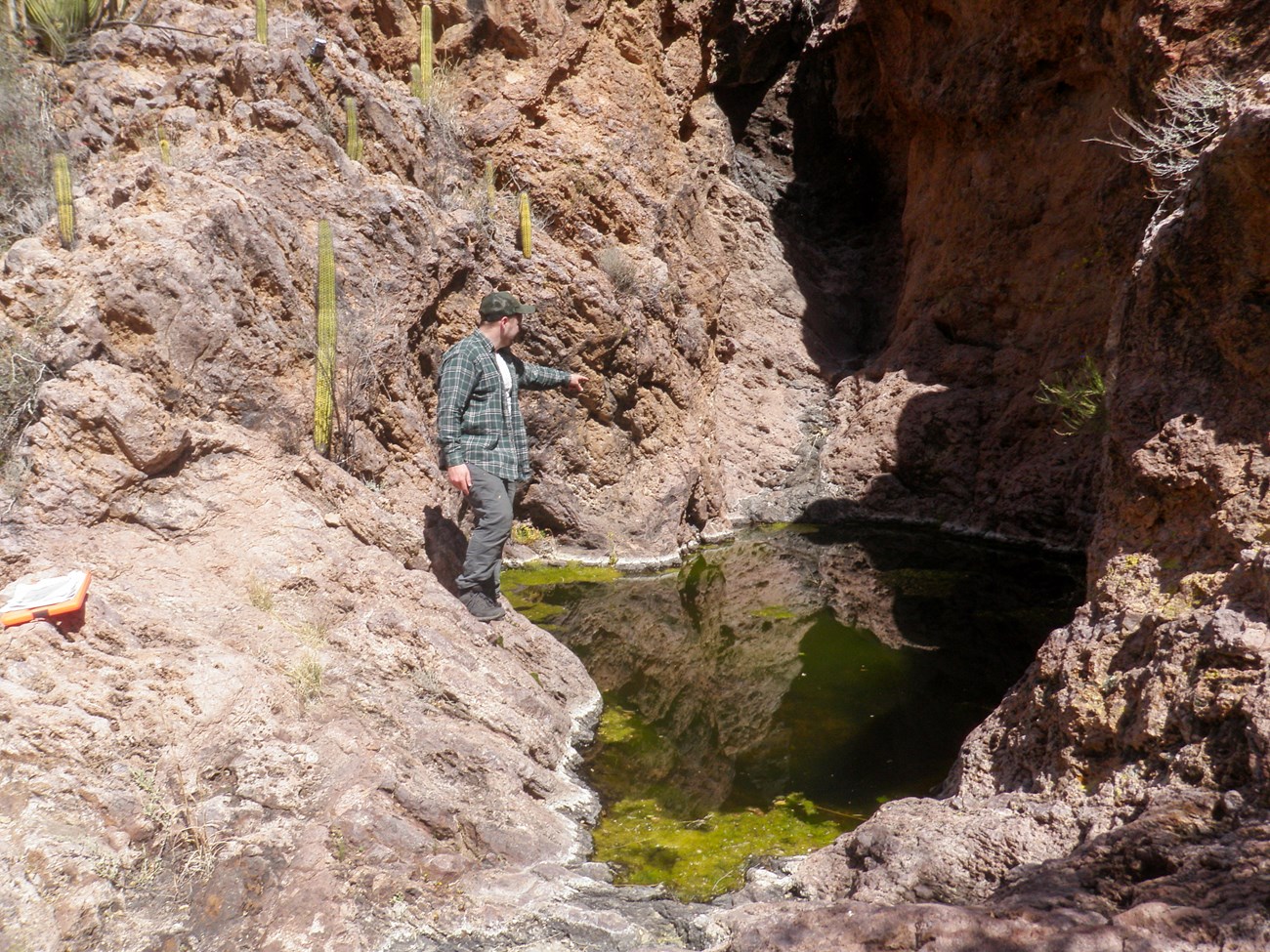
NPS
Recent Findings at East Arroyo Spring
East Arroyo Spring is a large persistent tinaja (pool in a rock basin) that lies at the base of a 10-meter bedrock cliff (Figure 7) within a large drainage below Ajo Peak (Figure 8). Another pool (not sampled) of similar size is located on the ledge above (Figure 8). When characterized in WY2022, the mostly shaded pool was about 8 m x 5 m and 1.5 m deep. Water stains around the surface of the pool, as well as a dry waterfall and outflow chute suggested these areas contain flowing water for extended periods of time. Descriptions and other characteristics of springs are updated every five years. The WY2022 visit occurred on 15 March 2022, and the spring contained water.
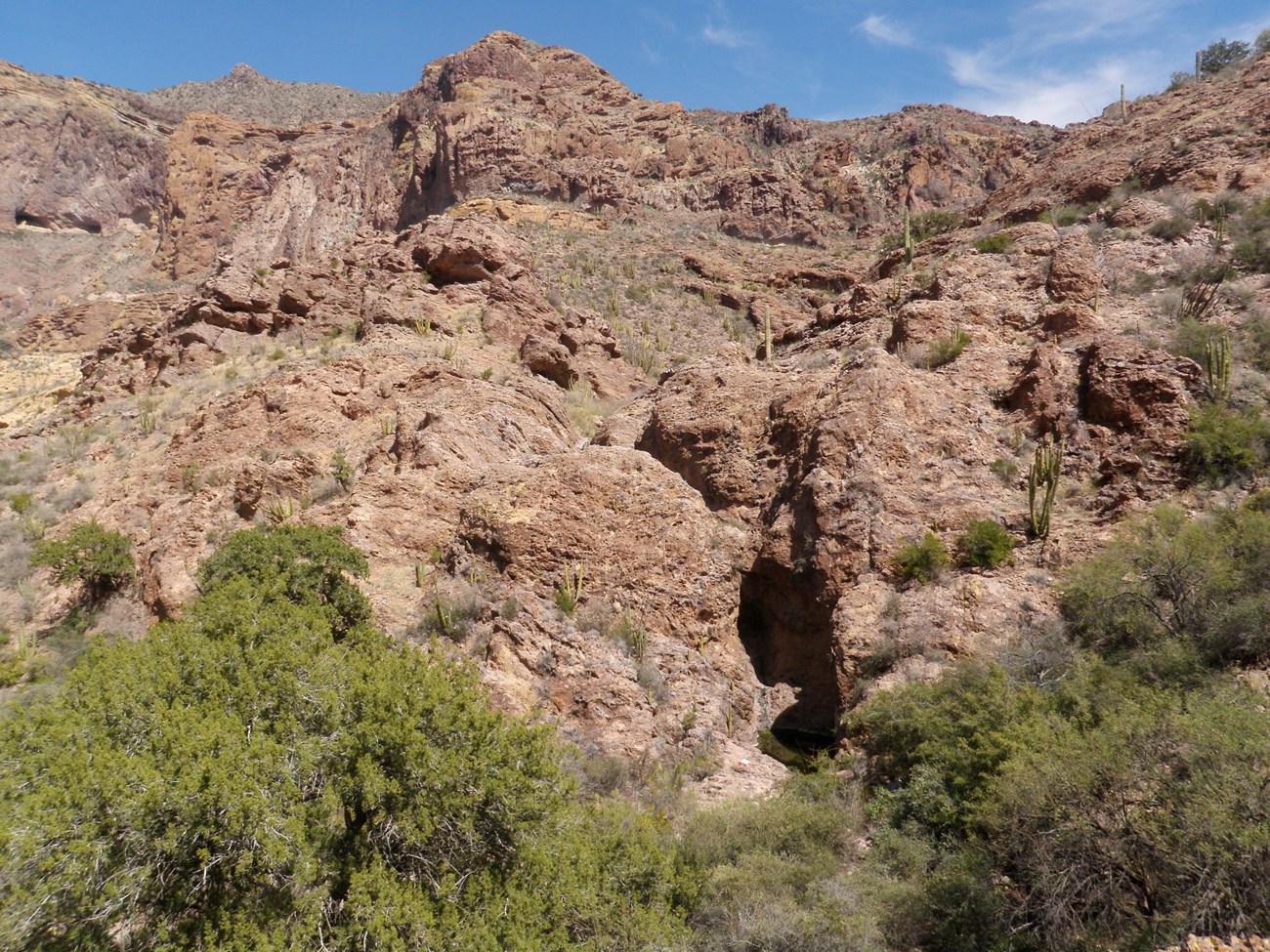
NPS
Site Condition
As in past years at East Arroyo Spring, we rated slight disturbance from the social trail that leads to spring from the ridge to the west near the end of the Bull Pasture Trail. No other natural or human-caused disturbances were observed at East Arroyo Spring in WY2022.
Consistent with previous visits, we did not observe crayfish or bullfrogs (non-native invasive aquatic animals) nor any non-native plants at East Arroyo Spring in WY2022. As in the past, the obligate wetland plant monkeyflower (Mimulus sp.) was detected in WY2022.
Inventory of Rare and Invasive Species and Pathogens
Four water samples were collected and filtered (0.45 µm mesh) from within the tinaja at East Arroyo Spring on 15 March 2022. None of our target organisms were detected.
Water Quantity
Temperature sensors indicated that East Arroyo Spring was ‘wetted’ (contained water) for all 166 days (100% of days) measured up to the WY2022 visit (Figure 9). In prior water years, the spring was wetted 56.5–100% of the days measured.
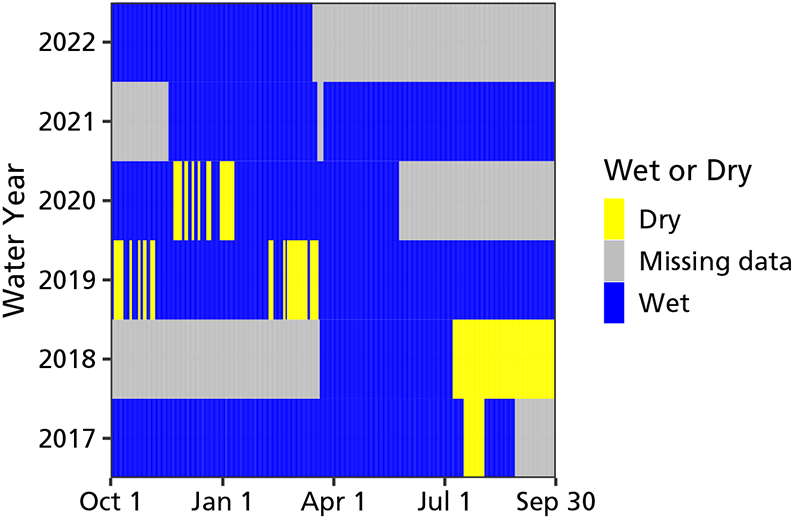
NPS
Discharge was not measured in WY2022 as there was no outflow from the tinaja (Table 5). Wetted extent could not be safely measured using the limnocrene method due to the steep walls surrounding the East Arroyo Spring.
Water Quality
Core water quality and water chemistry data were collected at the primary sampling location at East Arroyo Spring. The dissolved oxygen probe failed post-sampling calibration—as a result, we do not present this value. Specific conductivity and total dissolved solids were slightly lower and pH slightly higher than previous measurements (Table 6). Chloride was nearly 10 times higher than previously observed, yet all other chemistry parameters were well within the range of previous measures—we suspect a contamination issue or error during sample processing for chloride (Table 7).
East Arroyo Spring Data Tables
Sampling Location |
WY2022 Value (range of prior values) | Prior Years Measured (# of measurements) |
|---|---|---|
| 001 | c.n.s. (19.2–19.2) | 2019 (1) |
| Sampling Location | Measurement Location (width, depth) |
Parameter | WY2022 Value (range of prior values) |
Prior Years Measured (# of measurements) |
|---|---|---|---|---|
| 001 | Center | Dissolved oxygen (mg/L) | cal (9.35–13.15) |
2018–2021 (3) |
| 001 | Center | pH | 9.74 (7.92–9.32) |
2018–2021 (3) |
| 001 | Center | Specific conductivity (µS/cm) | 163.8 (179.5–283.5) |
2018–2021 (3) |
| 001 | Center | Temperature (°C) | 11.5 (11.4–13.4) |
2018–2021 (4) |
| 001 | Center | Total dissolved solids (mg/L) | 107.0 (116.3–184.6) |
2018–2021 (3) |
| Sampling Location | Measurement Location (width, depth) |
Parameter | WY2022 Value (range of prior values) |
Prior Years Measured (# of measurements) |
|---|---|---|---|---|
| 001 | Center | Alkalinity (CaCO3) |
60 (35–90) | 2018–2021 (3) |
| 001 | Center | Calcium (Ca) |
12 (14–22) | 2018–2021 (3) |
| 001 | Center | Chloride (Cl) |
400 (10–42) | 2018–2021 (3) |
| 001 | Center | Magnesium (Mg) |
2 (5–9) | 2018–2021 (3) |
| 001 | Center | Potassium (K) |
2.7 (2.8–4.1) | 2018–2021 (3) |
| 001 | Center | Sulphate (SO4) |
5 (0–4) | 2018–2021 (3) |
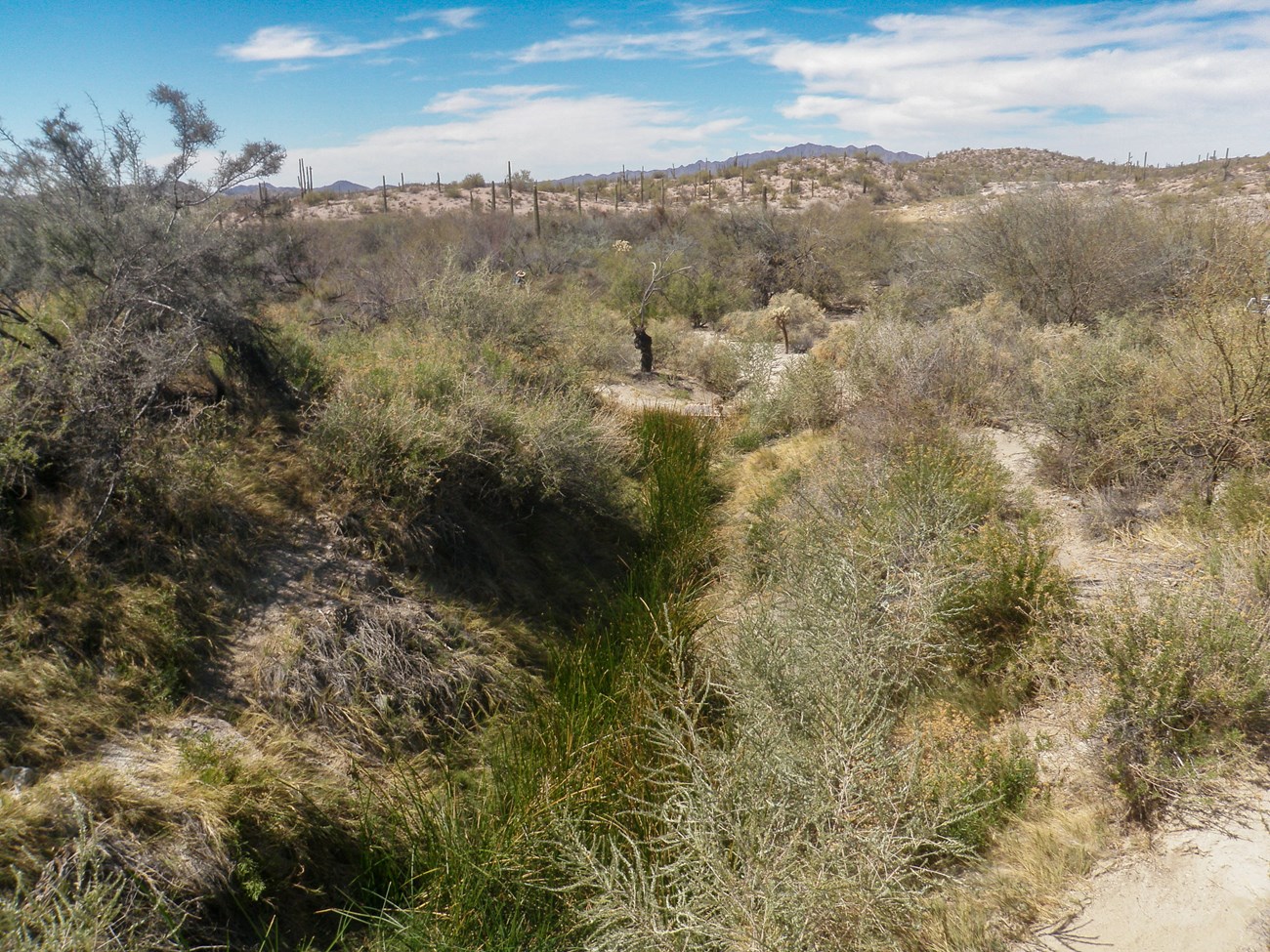
NPS
Recent Findings at Quitobaquito Spring
Quitobaquito Spring is a rheochrene spring (emerges as a flowing stream) that emerges from a low hill as a series of orifices that feed a 15 m long muddy seep (Figures 10–12) and pool that is constrained by a weir. Beyond that, the springbrook flows more than 200 m through a concrete channel and series of constructed pools (Figure 11) that support Quitobaquito Pond.
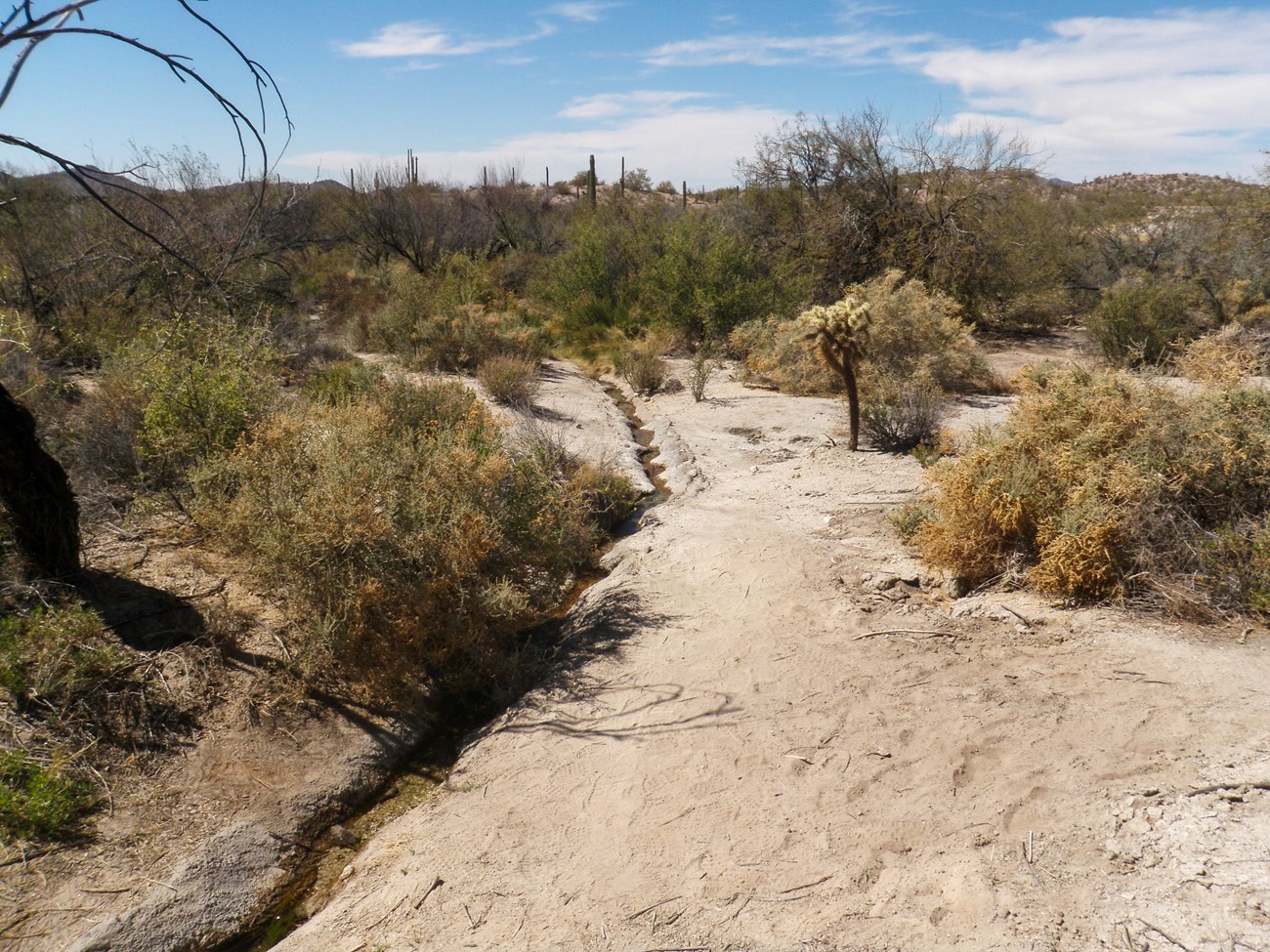
NPS
When characterized during the WY2022 visits, the pools and channel supported large numbers of pupfish and aquatic insects. Descriptions and other characteristics of springs are updated every five years. The WY2022 visit occurred on 13 March 2022, and the spring contained water.
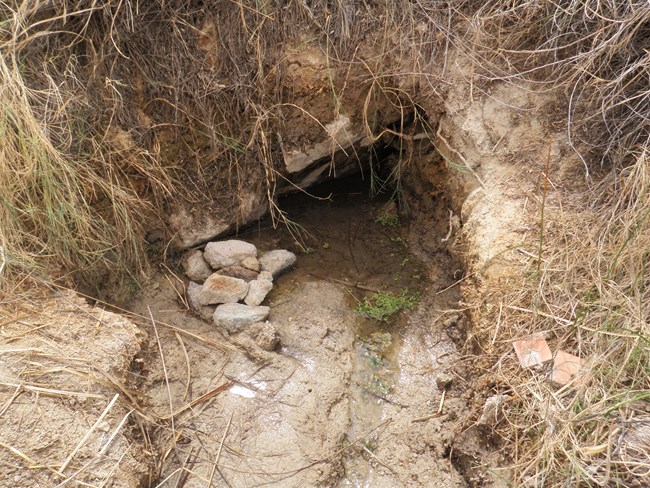
NPS
Site Condition
Consistent with past years, we noted “high disturbance” to Quitobaquito Spring from flow modification (the weir, concrete lined channel, and springbox for Orifice B), “moderate disturbance” from hiking trails (the well-used trail leading to the orifices and weir), and “slight disturbance” from contemporary human use—the USGS and NPS monitoring installations (pressure transducers and associated solar panels)—in WY2022. There were no other natural or human-caused disturbances observed at Quitobaquito Spring in WY2022.
Consistent with past years, we did not observe crayfish or bullfrogs (non-native invasive aquatic animals) at Quitobaquito Spring in WY2022. However, the non-native invasive grass Bermudagrass (Cynodon dactylon) was detected in a matrix in the slope around Orifice A (Figure 12). Bermudagrass was observed in 2017 but its density was not recorded.
Consistent with one or more past visits, we observed several obligate and facultative wetland plants: bulrush (Schoenoplectus sp.), cattail (Typhaceae), rabbitsfoot grass (Polypogon sp.), rush (Juncaceae), mule-fat (Baccharis salicifolia), sedge (Carex sp.), and spikerush (Eleocharis sp.).
Inventory of Rare and Invasive Species and Pathogens
Twenty-two water samples were collected and filtered (0.45 µm mesh) from the springbrook, pools, and pond at Quitobaquito Spring on 13 March 2022. None of our target organisms were detected, although five of the samples contained relatively high concentrations of biofilms or plant exudates that may have inhibited our ability to detect our target organisms.
Water Quantity
The water temperature sensor was missing (and replaced) on 13 March 2022, resulting in missing persistence data since the WY2021 visit. However, an adjacent USGS pressure transducer indicated that Quitobaquito Spring was wetted for the entire period between the WY2021 and WY2022 visits (USGS staff, personal communication). In prior water years, the spring was wetted 100% of the days measured (Figure 13).
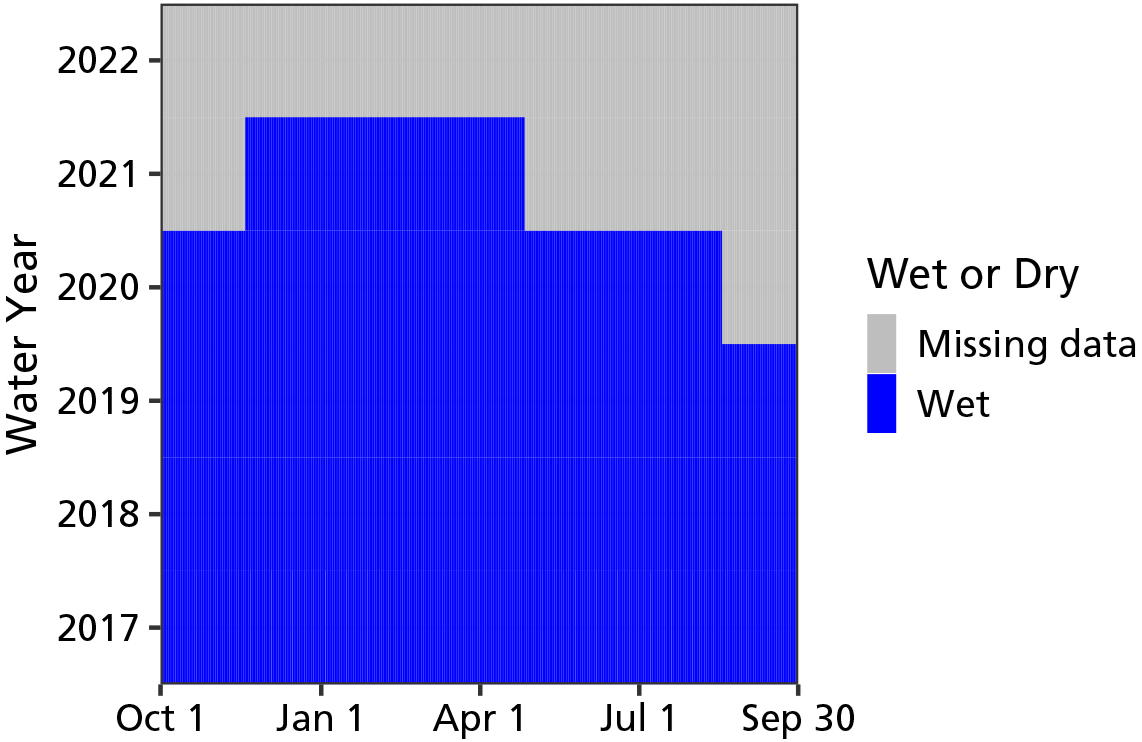
NPS
Discharge was estimated at 44.1 (± 6.3) L/min (11.6 ± 1.7 gal/min) in WY2022, which was on the upper range of previous measurements at Quitobaquito Spring (Table 8). Wetted extent was evaluated using a method for flowing water. The total brook length was 200–500 m (656–1,640 ft). Width and depth averaged 42.1 cm (16.6 in), and 8.8 cm (3.5 in), respectively, within the first 100 m—all extent measures for Quitobaquito Spring were within the range of prior measurements (Table 9).
Water Quality
Core water quality and water chemistry data were collected at the primary sampling location at Quitobaquito Spring in WY2022. The water chemistry sample had to be collected with a syringe due to the shallow depths at the primary sampling location; this may have affected our water chemistry results. Dissolved oxygen and pH were slightly lower (Table 10) and chloride was slightly higher (Table 11) than previously measured at Quitobaquito Spring.
Quitobaquito Spring Data Tables
Sampling Location |
WY2022 Value (range of prior values) | Prior Years Measured (# of measurements) |
|---|---|---|
| 003 | 44.1 ± 6.3 (33.0–44.1) | 2018–2021 (3) |
| Measurement | WY2022 Value (range of prior values) |
Prior Years Measured (# of measurements) |
|---|---|---|
| Width (cm) | 42.0 ± 37.8 (31.0–53.6) | 2017–2021 (4) |
| Depth (cm) | 8.8 ± 8.2 (4.2–12.9) | 2017–2021 (4) |
| Length (m) | 100 (100) | 2017–2021 (4) |
| Sampling Location | Measurement Location (width, depth) |
Parameter | WY2022 Value (range of prior values) |
Prior Years Measured (# of measurements) |
|---|---|---|---|---|
| 001 | Center | Dissolved oxygen (mg/L) | 5.19 (6.60–8.24) |
2017–2021 (3) |
| 001 | Center | pH | 7.45 (7.59–7.75) |
2017–2021 (3) |
| 001 | Center | Specific conductivity (µS/cm) | 1169 (1125–1181) |
2017–2021 (3) |
| 001 | Center | Temperature (°C) | 24.0 (23.7–26.6) |
2017–2021 (4) |
| 001 | Center | Total dissolved solids (mg/L) | 760 (731–767) |
2017–2021 (3) |
| Sampling Location | Measurement Location (width, depth) |
Parameter | WY2022 Value (range of prior values) |
Prior Years Measured (# of measurements) |
|---|---|---|---|---|
| 001 | Center | Alkalinity (CaCO3) |
250 (240–285) | 2017–2021 (3) |
| 001 | Center | Calcium (Ca) |
34 (22–34) | 2017–2021 (3) |
| 001 | Center | Chloride (Cl) |
180 (110–175) | 2017–2021 (3) |
| 001 | Center | Magnesium (Mg) |
17 (13–17) | 2017–2021 (3) |
| 001 | Center | Potassium (K) |
4.6 (4.3–4.7) | 2017–2021 (3) |
| 001 | Center | Sulphate (SO4) |
97 (77–104) | 2017–2021 (3) |
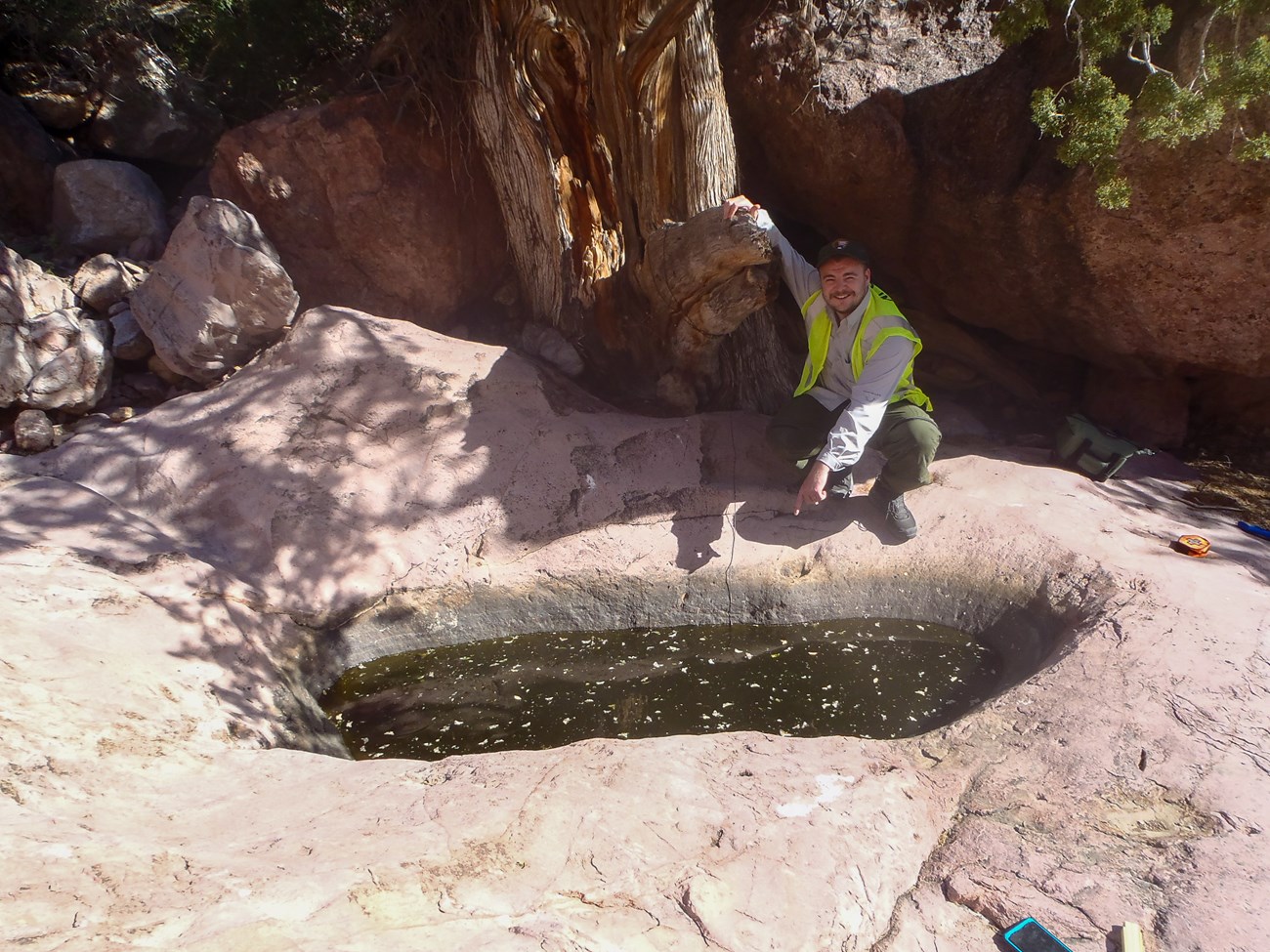
NPS
Recent Findings at Snake Pit Tinaja
Snake Pit Tinaja is a small (1 m x 3 m) tinaja (small pool in a rock basin) located within a steep, rocky section of the upper Alamo Canyon drainage. When visited and characterized in WY2022, Snake Pit Tinaja contained cold, dark green water littered with insect and leaf detritus. There was no outflow when observed, and a bathtub ring about 25 cm above water level suggested periods of higher water volumes. Descriptions and other characteristics of springs are updated every five years. The WY2022 visit occurred on 14 March 2022, and the spring contained water.
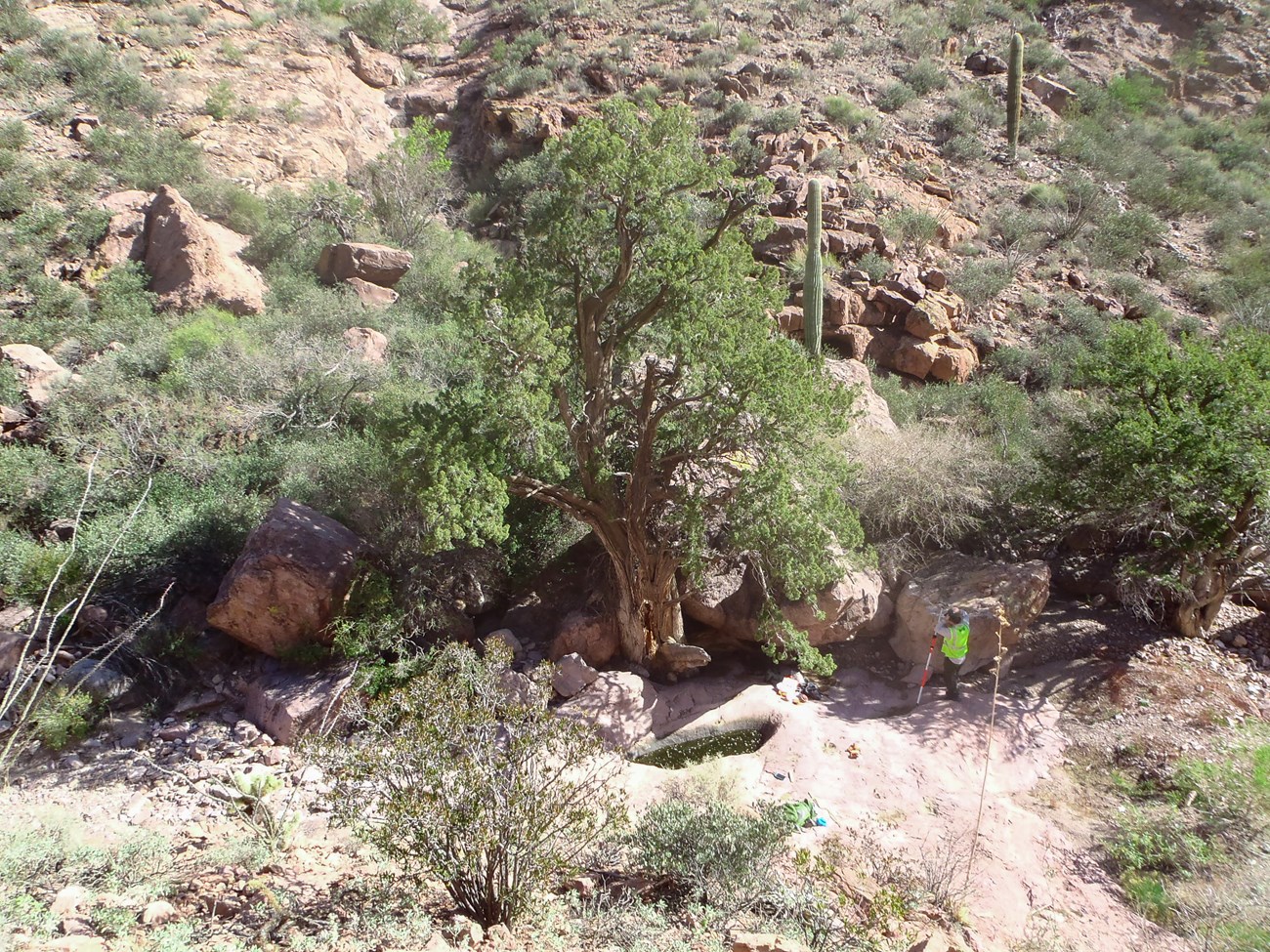
NPS
Site Condition
As in past years, in WY2022 we noted “slight disturbance” of Snake Pit Tinaja due to contemporary human use. We detected trash in an adjacent cave, human tracks, and soils disturbance around the tinaja, and the air temperature sensor was wrapped around a tree branch in a manner that suggested a human cause.
Consistent with all previous sampling at Snake Pit Tinaja, we did not observe crayfish or bullfrogs (non-native invasive aquatic animals), nor did we observe any non-native or obligate/facultative wetland plants in WY2022.
Inventory of Rare and Invasive Species and Pathogens
Four water samples were collected and filtered (0.45 µm mesh) from within Snake Pit Tinaja on 14 March 2022. None of our target organisms were detected.
Water Quantity
Temperature sensors indicated that Snake Pit Tinaja was "wetted" (contained water) for 156 of 165 days (94.5% of days) measured up to the WY2022 visit (Figure 16). As we approached the site on 14 March 2022, we observed that the water temperature sensor housing was out of the pool and neatly wrapped around a nearby tree limb, suggesting that a visitor or migrant may have pulled the sensor out of the water in the days before we sampled the site. In prior water years, the spring was wetted 84.8–99.5% of the days measured.
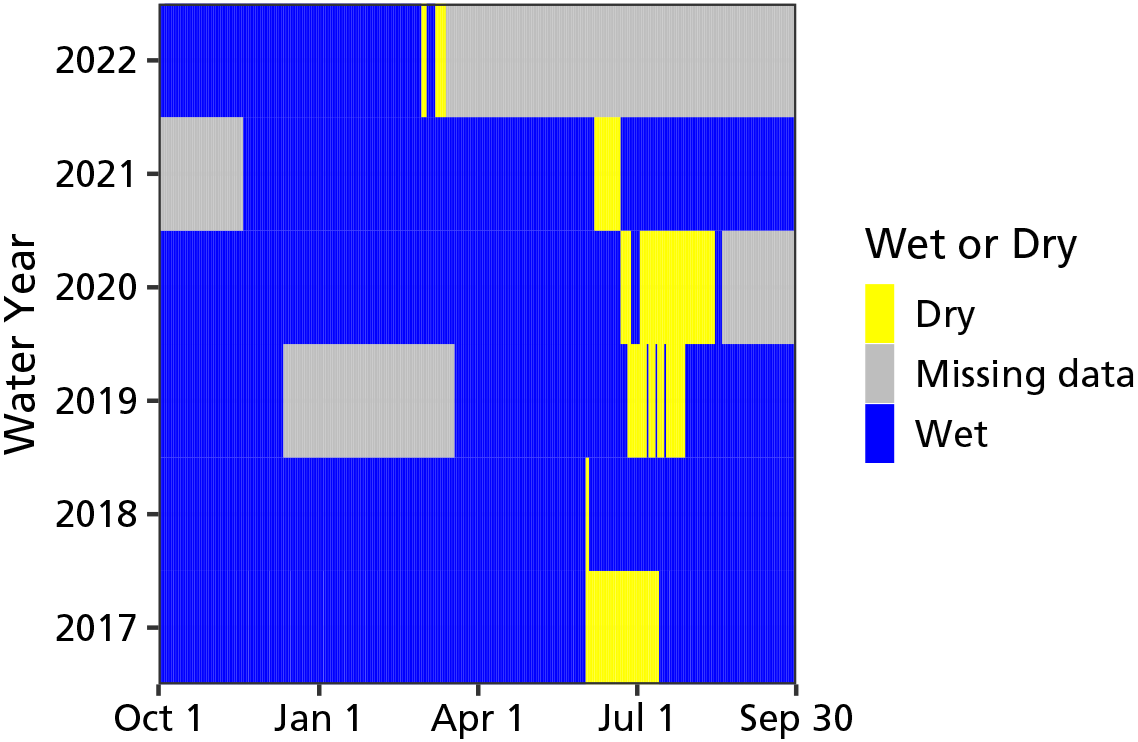
NPS
As in past years, there was no measurable discharge out of Snake Pit Tinaja. Wetted extent at Snake Pit Tinaja was evaluated using a method for standing water in WY2022. Width averaged 90.2 cm (35.5 in), length averaged 198.3 cm (78.1 in), and depth averaged 52.2 cm (20.5 in)—all on the higher end of the range measured in past years (Table 12).
Water Quality
Core water quality and water chemistry data were collected at the primary sampling location at Snake Pit Tinaja in WY2022. The water quality sonde failed post-calibration for dissolved oxygen, pH, and specific conductivity—data for these parameters are not presented. Water temperature was within the range of past measurements (Table 13). Water chemistry values were within the range recorded in prior years except for chloride, which was about 5 times higher than previously measured at Snake Pit Tinaja (Table 14). We were unable to prevent fine detritus (mostly fragments of insect carcasses) from entering the water sample, which may have influenced our water chemistry values.
Snake Pit Tinaja Data Tables
| Measurement | WY2022 Value (range of prior values) |
Prior Years Measured (# of measurements) |
|---|---|---|
| Width (cm) | 90.2 ± 11.9 (41.2–108.8) | 2018–2021 (3) |
| Depth (cm) | 52.2 ± 10.8 (14.5–67.3) | 2018–2021 (3) |
| Length (cm) | 198.3 ± 37.9 (65.0–241.7) | 2018–2021 (3) |
| Sampling Location | Measurement Location (width, depth) |
Parameter | WY2022 Value (range of prior values) |
Prior Years Measured (# of measurements) |
|---|---|---|---|---|
| 001 | Center | Dissolved oxygen (mg/L) | cal (2.97–13.56) |
2017–2021 (4) |
| 001 | Center | pH | cal (7.55–9.67) |
2017–2021 (4) |
| 001 | Center | Specific conductivity (µS/cm) | cal (264–1045) |
2017–2021 (4) |
| 001 | Center | Temperature (°C) | 10.3 (9.8–15.2) |
2017–2021 (5) |
| 001 | Center | Total dissolved solids (mg/L) | 195.0 (165.1–676.0) |
2017–2021 (4) |
| Sampling Location | Measurement Location (width, depth) |
Parameter | WY2022 Value (range of prior values) |
Prior Years Measured (# of measurements) |
|---|---|---|---|---|
| 001 | Center | Alkalinity (CaCO3) |
120 (55–470) | 2017–2021 (4) |
| 001 | Center | Calcium (Ca) |
28 (8–74) | 2017–2021 (4) |
| 001 | Center | Chloride (Cl) |
155 (b.d.l.–29) | 2017–2021 (4) |
| 001 | Center | Magnesium (Mg) |
b.d.l. (b.d.l.–7) | 2017–2021 (4) |
| 001 | Center | Potassium (K) |
6.3 (3.6–9.5) | 2017–2021 (4) |
| 001 | Center | Sulphate (SO4) |
0 (0–9) | 2017–2021 (4) |
Report Citation
Authors: Kara Raymond, Andy Hubbard, Cheryl McIntyre
Raymond, K., A. Hubbard, and C. McIntyre. 2024. Climate and Water Monitoring at Organ Pipe Cactus National Monument: Water Year 2022. Sonoran Desert Network, National Park Service, Tucson, Arizona.
